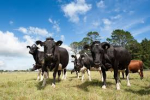Taranaki dairy farmers are enduring a terrible facial eczema onslaught.
DairyNZ's regional leader in the province, Katrina Knowles, says this extraordinary year has whole herds showing clinical signs of the disease.
FE has occurred in Taranaki before, but never this bad, she says. The disease is spread right across the province.
"The last time we had a real outbreak was in the 1980s," but never with counts this bad. "Some of the counts just skyrocketed away. In the past we had a 250,000 count, but this year they are past the million," she says.
Knowles says the outbreak is due to high temperatures followed by rain which set up the conditions for FE to take hold in the lower base of grass grazed by stock.
Unusually, dairy farms high up near the bushline of Mt Taranaki are as badly affected as those at lower altitudes near the coast. Sheep and beef farmers are similarly hit.
"The farmers around the mountain never thought they would get it. For years they have probably done nothing to prevent it, but even those people who were treating it by spraying and doing everything right still ended up with FE this year," she says.
The big thing now is for farmers to make sure their cows are not stressed in any way in the lead up to calving. Any farmer seeking help to deal with FE is getting it from DairyNZ. (A DNZ website section dedicated to FE shows how to detect and treat it.)
"The big thing is that people will feed animals that have been affected clinically and they know how to deal with them and to preferentially feed them. But if they have clinical animals they will have sub-clinical animals showing no outward signs of being affected by FE. The sub-clinical ones also need care -- good levels of high energy feed, good quality pasture forages and supplements," she says.
Knowles says farmers should be trying to raise the condition score of their cows to get them ready for calving. But with calving in many parts of the province only weeks away that will be difficult.
"We all know that animals don't put on weight in the last three weeks of pregnancy so we have limited time now. Farmers must manage what they can and not set too high expectations," she says.
Knowles says farmers should act now, seperating FE cows from the main herd and giving injectible vitamin B12 to stimulate appetite. Preferential feeding will also improve body condition score, taking them closer to the optimum BCS 5.0 for mature cows or 5.5 for first and second calvers. Other treatments should continue -- magnesium during the dry period and minerals copper, selenium and cobalt.
FE rife in other regions
DairyNZ general manager extension Andrew Reid says facial eczema is also hurting herds in other regions of the North Island.
Waikato, Manawatu and parts of Bay of Plenty are hard-hit.
DairyNZ is concerned about the effect such a high incidence of clinical cases will have on production next season, Reid says. And lots of clinical cases signal a higher rate of sub-clinical cases -- a real concern.
"If it's as severe as we're told, there will be a carryover effect into the spring, impacting production; but at this stage I can't say exactly what level that might be. A lot depends on how the winter period plays out," he says.
Reid says farmers need to be vigilant in the coming months to deal with issues possibly arising from cows affected by FE.
About facial eczema
Facial eczema is caused by a toxin (sporisdesim) produced by the spores of the fungus Pithomyces chartarum growing on pasture.
The fungus grows in the dead litter at the base of pasture in warm moist conditions.
Sporisdesim, when ingested by cattle, damages the liver and bile ducts. The damaged liver cannot rid the body of wastes and a breakdown product of chlorophyll builds up in the blood causing sensitivity to sunlight, which in turn causes inflammation of the skin.
Signs to look for
· Drop in milk production
· Cows are restless, seeking shade and licking their udders
· Exposed unpigmented or thin skin reddens, thickens and peels.
Not all animals with FE show physical signs (i.e. clinical FE) although liver damage (i.e. subclinical FE) has occurred. It is estimated that for every clinical case there will be 10 cows with subclinical FE.
Milk production by animals with subclinical FE can be depressed by up to 50%. Blood tests can be used to monitor the extent of subclinical FE.
Badly damaged liver tissue will not regenerate. Chronic wasting and/or death may occur at the time of damage or months later when the animal is under stress (e.g. calving).


















